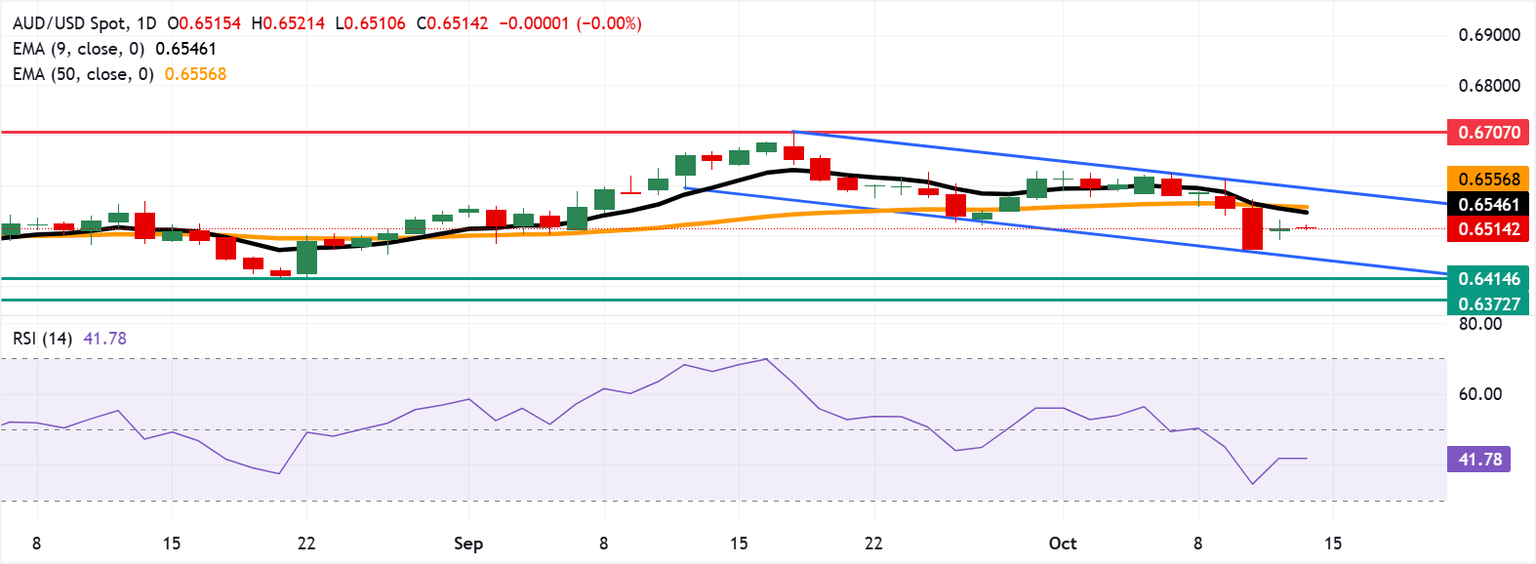Australian Dollar edges lower as US Dollar holds ground on market caution

The Australian Dollar (AUD) holds ground against the US Dollar (USD) on Tuesday. The AUD/USD pair moves little following the release of the Reserve Bank of Australia’s (RBA) Minutes of its September monetary policy meeting, which showed that board members agreed that policy was still a little restrictive but difficult to determine.
The RBA Meeting Minutes also noted that economic risks persist, with consumption remaining weak amid softer job and wage growth. Monthly CPI data for housing and services suggest that Q3 inflation may exceed forecasts.
Market sentiment remains cautious after RBA Governor Michele Bullock remarked last week that services inflation remains somewhat persistent. She acknowledged that second-quarter inflation was slightly above expectations but continues to move in the right direction.
Australia’s Consumer Inflation Expectations rose to 4.8% in October, up from 4.7% previously, the highest level since June. Growing concerns that inflation may surpass forecasts in Q3 reinforce the cautious outlook surrounding the Reserve Bank of Australia. Traders largely expect the RBA to hold interest rates steady after keeping the Official Cash Rate unchanged at 3.6% in September.
US Dollar steadies ahead of Fed Chair Powell’s speech
- The US Dollar Index (DXY), which measures the value of the US Dollar against six major currencies, is remaining steady and trading around 99.30 at the time of writing. Traders will likely observe the speech from US Federal Reserve (Fed) Chair Jerome Powell later in the day.
- The CME FedWatch Tool suggests that markets are now pricing in nearly a 97% chance of a Fed rate cut in October and a 92% possibility of another reduction in December.
- Philadelphia Fed President Anna Paulson said on Monday that rising risks to the job market argue for more interest rate cuts by the US central bank, as trade tariffs now appear unlikely to push up inflation as much as expected.
- The Federal Open Market Committee (FOMC) Minutes from the September meeting suggested policymakers are leaning toward further rate cuts this year. The majority of policymakers supported the September rate cut and signaled further reduction later this year. However, some members favored a more cautious approach, citing concerns about inflation.
- US President Trump stated on Friday that there was no reason to meet with China’s President Xi Jinping during the upcoming summit in South Korea in two weeks. Trump also announced plans to impose 100% tariffs on Chinese imports. However, Trump shared some conciliatory remarks in his post on Truth Social on Sunday, noting that China’s economy “will be fine” and that the US wants to “help China, not hurt it.”
- China’s Commerce Ministry announced on Thursday that the country will tighten rules on rare earth exports, effective December 1. Foreign businesses and individuals must obtain a dual-use items export license for rare earth exports.
- China’s Trade Balance arrived at CNY645.47 billion in September, narrowing from the previous figure of CNY732.7 billion. Exports rose 8.4% YoY in September vs. 4.8% in July. The country’s imports advanced 7.5% YoY in the same period vs. 1.7% recorded previously. In US Dollar (USD) terms, China’s Trade Surplus came at $90.45 billion, expanded less than expected $98.96 billion in September, and was down from the previous $102.33.
- Reuters, citing a report from The Age on Sunday, said a leaked brief from Australia’s Prime Minister Anthony Albanese’s department revealed that government officials have begun discussions with miners about contributing to a A$1.2 billion ($776.28 million) “critical minerals strategic reserve.” Australia is considering setting minimum prices for critical minerals and providing funding for new rare earth projects under a proposed resources agreement with the United States.
Australian Dollar holds above 0.6500 to target nine-day EMA barrier
The AUD/USD pair is trading around 0.6510 on Tuesday. Technical analysis on the daily chart suggests a prevailing bearish bias as the pair is moving downwards within a descending channel pattern. Additionally, the 14-day Relative Strength Index (RSI) remains below the 50 level, strengthening a bearish bias.
On the downside, the AUD/USD pair may target the lower boundary of the descending channel around 0.6460. A break below the channel would strengthen the bearish bias and prompt the pair to test the four-month low of 0.6414, recorded on August 21, followed by the five-month low of 0.6372.
The initial barrier lies at the nine-day Exponential Moving Average (EMA) of 0.6546, followed by the 50-day EMA at 0.6556. A break above these levels would improve the short- and medium-term price momentum and lead the AUD/USD pair to test the descending channel’s upper boundary around 0.6600. Further advances above the channel would cause the emergence of the bullish bias and support the pair to explore the region around the 12-month high of 0.6707, recorded on September 17.
(The story was corrected on October 14 at 02:20 GMT, to say in the first bullet point and first paragraph that the RBA Minutes of its September meeting, and not of the October meeting.)
AUD/USD: Daily Chart

Australian Dollar Price Today
The table below shows the percentage change of Australian Dollar (AUD) against listed major currencies today. Australian Dollar was the weakest against the Euro.
| USD | EUR | GBP | JPY | CAD | AUD | NZD | CHF | |
|---|---|---|---|---|---|---|---|---|
| USD | -0.00% | -0.01% | 0.05% | 0.05% | 0.17% | 0.17% | 0.04% | |
| EUR | 0.00% | -0.00% | 0.05% | 0.05% | 0.23% | 0.19% | 0.05% | |
| GBP | 0.01% | 0.00% | 0.08% | 0.07% | 0.22% | 0.21% | 0.06% | |
| JPY | -0.05% | -0.05% | -0.08% | 0.00% | 0.10% | 0.09% | -0.05% | |
| CAD | -0.05% | -0.05% | -0.07% | -0.01% | 0.16% | 0.12% | -0.01% | |
| AUD | -0.17% | -0.23% | -0.22% | -0.10% | -0.16% | -0.04% | -0.17% | |
| NZD | -0.17% | -0.19% | -0.21% | -0.09% | -0.12% | 0.04% | -0.13% | |
| CHF | -0.04% | -0.05% | -0.06% | 0.05% | 0.00% | 0.17% | 0.13% |
The heat map shows percentage changes of major currencies against each other. The base currency is picked from the left column, while the quote currency is picked from the top row. For example, if you pick the Australian Dollar from the left column and move along the horizontal line to the US Dollar, the percentage change displayed in the box will represent AUD (base)/USD (quote).
RBA FAQs
The Reserve Bank of Australia (RBA) sets interest rates and manages monetary policy for Australia. Decisions are made by a board of governors at 11 meetings a year and ad hoc emergency meetings as required. The RBA’s primary mandate is to maintain price stability, which means an inflation rate of 2-3%, but also “..to contribute to the stability of the currency, full employment, and the economic prosperity and welfare of the Australian people.” Its main tool for achieving this is by raising or lowering interest rates. Relatively high interest rates will strengthen the Australian Dollar (AUD) and vice versa. Other RBA tools include quantitative easing and tightening.
While inflation had always traditionally been thought of as a negative factor for currencies since it lowers the value of money in general, the opposite has actually been the case in modern times with the relaxation of cross-border capital controls. Moderately higher inflation now tends to lead central banks to put up their interest rates, which in turn has the effect of attracting more capital inflows from global investors seeking a lucrative place to keep their money. This increases demand for the local currency, which in the case of Australia is the Aussie Dollar.
Macroeconomic data gauges the health of an economy and can have an impact on the value of its currency. Investors prefer to invest their capital in economies that are safe and growing rather than precarious and shrinking. Greater capital inflows increase the aggregate demand and value of the domestic currency. Classic indicators, such as GDP, Manufacturing and Services PMIs, employment, and consumer sentiment surveys can influence AUD. A strong economy may encourage the Reserve Bank of Australia to put up interest rates, also supporting AUD.
Quantitative Easing (QE) is a tool used in extreme situations when lowering interest rates is not enough to restore the flow of credit in the economy. QE is the process by which the Reserve Bank of Australia (RBA) prints Australian Dollars (AUD) for the purpose of buying assets – usually government or corporate bonds – from financial institutions, thereby providing them with much-needed liquidity. QE usually results in a weaker AUD.
Quantitative tightening (QT) is the reverse of QE. It is undertaken after QE when an economic recovery is underway and inflation starts rising. Whilst in QE the Reserve Bank of Australia (RBA) purchases government and corporate bonds from financial institutions to provide them with liquidity, in QT the RBA stops buying more assets, and stops reinvesting the principal maturing on the bonds it already holds. It would be positive (or bullish) for the Australian Dollar.





